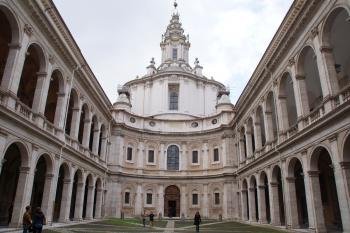
Rome is one of my favourite cities, it has an incredible number of historical monuments and despite the crowds of tourists, it is an enchanting and exciting capital. I have visited Rome several times, usually only for a short stay, but in November 2013, we spent five days in Rome. We had seen the main tourist sights on previous visits, and thus we had plenty of time to explore the city without haste and to visit also some of the lesser known sites.
A few suggestions that might be interesting for visitors who have time for more than just the Top Ten sights:
First: the three papal basilicas San Paolo fuori le Mura, Santa Maria Maggiore, and San Giovanni in Laterano (St. Peter's is the fourth). Of these, I was most impressed by San Paolo, even more than by St. Peter's, though the basilica is relatively new. It was rebuilt after a fire in the mid-19th century. The large and almost empty nave is amazing, it has a length of 130 meters and four rows of columns. The name of the basilica is derived from its location outside the ancient Aurelian walls, today it is a rather insignificant neighbourhood. It is easy to get to by public transport, it is right next to the metro station Basilica San Paolo. I also liked San Giovanni in Laterano, most striking are the huge statues of the twelve apostles in the nave. The Lateran complex includes also the Lateran Baptistery, the Scala Sancta and the Triclinium of Pope Leo III.
Next on our list: the three churches with works by Caravaggio, the enigmatic Baroque painter known for his brilliant use of chiaroscuro (strong contrasts of light and dark). A must see, not only for art enthusiasts, is San Luigi dei Francesi with three paintings in a side chapel. The church is close to Piazza Navona, there are always many tourists, but nevertheless a stunning impression. The two other churches with Caravaggio paintings are Santa Maria del Popolo (Piazza del Popolo) and Sant’Agostino in Campo Marzio (close to Piazza Navona). In Rome, admission to churches is free, but they found a clever way to earn some money: you have to insert 50 Cents to switch the lights on for a few minutes to see the paintings.
A bit off the beaten track: the Baths of Caracalla, located in a nice park in the south of the WHS core zone. Although only the walls have been preserved, the sequence of the rooms is still visible and the sheer size of this huge leisure complex is amazing.
The Tempietto di Bramante, a lovely little Renaissance chapel, only a short walk from Piazza Santa Maria in Trastevere, but easy to miss, because it is hidden in the courtyard of the monastery San Pietro in Montorio.
Of course, we visited also our favourite places: the Pantheon, in my opinion the most outstanding building in Rome, Trastevere at night, and the Campo de' Fiori in the morning with a nice food market popular with tourists and locals
And finally my favourite building in Rome: the Baroque church Sant’Ivo alla Sapienza (photo). My first visit was just by chance, I followed a group of tourists through a rather inconspicuous portal. Then I stood in a courtyard with two-storey arcades and was surprised to find such a quiet place in the heart of Rome, right next to Piazza Navona. The architecture is unique in almost every respect. The façade was embedded in the previously existing courtyard of the Palazzo della Sapienza and therefore it has a concave shape. The dome is crowned by a squiggly spiral-shaped tower. And the interior is also unusual, the floor plan is constructed from an equilateral triangle, the sides have semicircular bulges and the angles are cut off. This results in a complex shape of the dome with alternating convex and concave segments that gradually converts the floor plan into a perfect circle at the top of the dome. Unfortunately, the church is open only on Sunday morning.
As Ian Cade quoted in his review: Rome, a lifetime is not enough. There is nothing more to add.
Comments
No comments yet.
